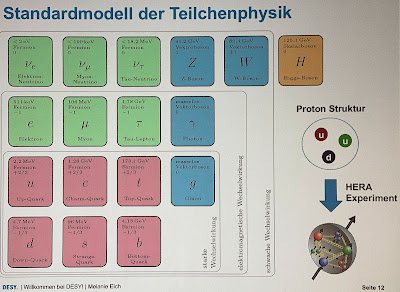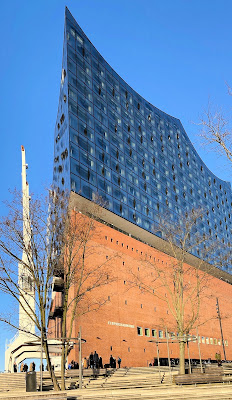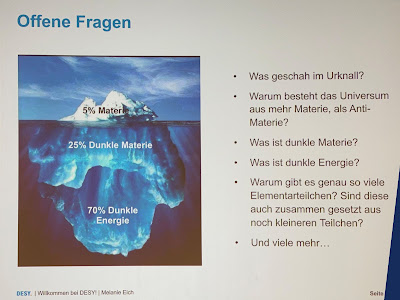In January 2017, I was in Hamburg to listen to a concert at the Elbphilharmonie (Elphi). This new landmark had been inaugurated just the week before. The resulting trilogy of blogs further described some highlights of Hamburg and concentrated on the famous Miniatur Wunderland.
Last year, I was in Hamburg for my class reunion in September, then in November, and later, I celebrated the turn of the year on a boat on the Elbe River.
My visit in November had a double purpose.
The Fachverband für Strahlenschutz (FFS), the German-Swiss Radiation Protection Society, hosted a two-day seminar on the new German Radiation Protection Act at DESY (Deutsches Elektronen-Synchrotron), the high-energy physics laboratory located in Hamburg. Retired members of the Fachverband paid a well-reduced conference fee, including a guided tour of DESY. That made me curious to learn about new developments in my old trade.
The other reason for my trip was to determine whether the visitors' tour of DESY would be worth an excursion to Hamburg in 2020 in the framework of the "Museumsreisen." You may know that Red Baron is a member of Freiburg's oldest citizen society of 1807, called Museumsgesellschaft. Last year, our society visited the city of Schwäbisch Hall and its surroundings. I published some stray observations in a blog as splinters during that trip.
On November 17, Red Baron boarded the ICE train from Freiburg to Hamburg. The ride took six and a half hours, but I like soft traveling, although I no longer enjoy Butterkuchen (with time," the quality of the cake was strained"). I would rather have a pot of coffee served on the train with a slightly salty and crusty Laugen croissant bought at Freiburg's train station.
I stayed at the Hotel Harbor Hamburg near the S-Bahn station Landungsbrücken (jetty facilities).

|
| View of the Landungsbrücken at the waterfront. The display on the tower to the left shows the tide mark. |
On the waterfront at Landungsbrücken in the evening, I had one of the best Finkenwerder Speckscholle (a plaice baked in finely diced bacon) in my life, crowned by a Hamburger Rote Grütt (red berry groats with vanilla ice cream instead of the original vanilla custard).
The hotel featured a tower with a bar that offered fantastic views of the city and harbor.

|
|
Looking upstream: In the back, in the middle, the dark silhouette of the Elbphilharmonie |

|
|
Looking downstream: The dome of the Elbtunnel in the middle, near the waterfront, and illuminated dry docks in the background |
FFS
What did I learn at the seminar on radiation protection, having been out of business for nineteen years? Twenty years ago, the annual dose limit to the body of persons exposed to ionizing radiation in exercising their profession had been lowered from 50 to 20 mSv, and radiation protection had lost the notion of critical organs that had to be specially protected.Now, the "lens of the eye" rears its head again as a "critical organ" with a dose limit of 20 mSv annually. In fact, there may be radiation situations where special efforts must be made to protect the lens from beta radiation.
This is not true for flying personnel exposed to high-energy radiation during flights. Their individual doses are not measured but calculated and attributed to the route flown. Nowadays, pilots and cabin crews are among the most exposed people.
DESY
During the introduction to and before the guided tour of DESY, I learned that the institute is now part of the Helmholtz Community, a network of German research institutes.

|
|
In the interactions of high-energy electrons with high-energy protons,
the electrons explore the structure of protons by deep inelastic scattering. |

|
|
Inside the HERA tunnel. The dismantling of the accelerator is too
expensive. Abandoned and partially cannibalized, it is showcased as a highlight for visitors. |

|
|
Starting at DESY and heading over 3.4 kilometers northwest into the neighboring State of Schleswig-Holstein. |
commissioned in 2017. The machine is constructed such that the electrons produce X-ray light in synchronization, resulting in high-intensity X-ray pulses with the properties of laser light and at intensities much brighter than those produced by conventional synchrotron light sources (Wikipedia).

|
| Showing the basic building blocks of matter. |
The latest LHCb result is the first test of lepton universality made using the decays of beauty baryons – three-quark particles containing at least one beauty quark. Sifting through proton-proton collision data at energies of 7, 8, and 13 TeV, the LHCb researchers identified beauty baryons called Λb0 and counted how often they decayed to a proton, a charged kaon, and either a muon and antimuon or an electron and antielectron.
The team then took the ratio between these two decay rates. If lepton universality holds, this ratio should be close to 1. A deviation from this prediction could, therefore, signal a violation of lepton universality. Such a violation could be caused by the presence in the decay of a never-before-spotted particle not predicted by the Standard Model.
The team obtained a ratio slightly below 1, with a statistical significance of approximately 1 standard deviation, which is well below the 5 standard deviations required to claim a real difference in the decay rates. The researchers say that the result aligns with other findings, which have observed hints that decays to a muon–antimuon pair occur less frequently than those to an electron–antielectron pair. Still, they also stress that much more data is needed to tell whether this oddity in the behavior of leptons is here to stay or not.
Read the full article here.
There are many open questions in physics, particularly about dark matter and energy. And here is a "wanted" poster with fancy "names" to illustrate what we still do not know but would like to learn.
DESY can no longer fly on the one wing of high-energy physics. The Federal Republic and the Hamburg Senate will transform the DESY complex into a multidisciplinary Science City, aiming for synergistic effects in the years to come.
The taste of Hamburg or Franzbrötchen is just delicious.

|
| A unique outlet at Hamburg's Central Station. |

|
| franz & friends offer the standard variety, but also fancy new creations of Franzbrötchen. |
*











No comments:
Post a Comment